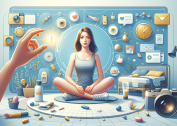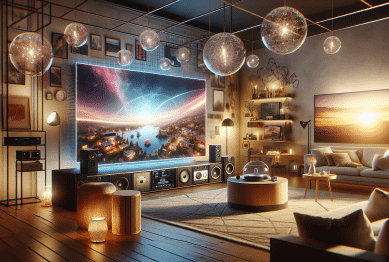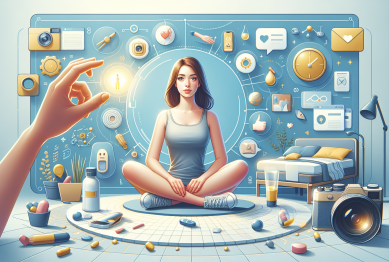Dive into a different kind of lifestyle upgrade. This article explores unique trends, creative entertainment tips, and easy ways anyone can transform their daily routine for more joy and energy.
Discovering Unique Lifestyle Trends for Personal Growth
Lifestyle trends have evolved far beyond following mainstream fashion or entertainment news. Today, individuals are seeking hidden gems in the realms of personal growth and well-being, often tapping into minimalist living or ‘slow living’ movements. These alternative trends encourage making conscious decisions about consumption, focusing on experiences over objects, and integrating wellness practices into daily routines. For many, it starts with curating their environment—removing clutter, choosing calming colors, and welcoming only items or experiences that bring joy. This pursuit of intentional, meaningful living is not only energizing but also proven to increase overall happiness and life satisfaction (Source: https://www.nimh.nih.gov/health/topics/caring-for-your-mental-health).
Some embrace wellness routines inspired by global traditions—such as Swedish lagom (balance), Japanese forest bathing, or Danish hygge (comfort and coziness). These concepts have gained traction because they offer practical tools for managing everyday stress and enhancing life’s simple pleasures. Incorporating even small aspects of such traditions can have a powerful impact. Imagine dedicating ten quiet minutes to a morning walk or enjoying a mindful cup of tea. Studies suggest regular engagement in mindful practices can positively affect mood, focus, and energy throughout the day (Source: https://www.apa.org/topics/mindfulness).
Progressive lifestyle trends now seamlessly blend wellness, entertainment, and personal expression. More people are integrating creative hobbies like journaling, digital illustration, or even learning a musical instrument. These activities are accessible and often low- or no-cost, yet contribute significantly to emotional well-being and continuous self-discovery. Exploring new lifestyle avenues, especially those rooted in cultural practices, opens doors to inspiration and stronger connections—both with oneself and a wider global community. Many find lasting fulfillment pursuing a lifestyle that is uniquely their own.
Creative Entertainment at Home That Energizes and Inspires
Entertainment isn’t limited to passive activities like binge-watching shows. In fact, many are finding joy and stimulation through creative projects at home. Do-it-yourself (DIY) entertainment options such as home karaoke, themed dinner nights, or mini art shows can breathe new life into familiar settings. Reimagining a living room as a movie theater or inviting friends for impromptu talent hours encourages interaction and spontaneity. Emerging trend reports point to a surge in interest for these at-home experiences, as people seek meaningful, cost-effective ways to relax and connect (Source: https://www.pewresearch.org/internet/2021/06/23/americans-and-digital-knowledge/).
Many families and roommates are rediscovering classic board games, interactive storytelling, or group video calls with distant friends as sources of amusement. With a little imagination, even baking together or crafting a DIY escape room can become memorable entertainment. These shared moments provide a positive boost and help strengthen relationships. Whether through laughter, learning something new, or expressing creativity, home-based entertainment easily nurtures well-being and social bonds.
The rapid expansion of digital platforms has made virtual entertainment options endless. Interactive online quizzes, live concerts, and collaborative art sessions bring people together across distances. Accessible tech tools allow users to host their own digital trivia nights or collaborative playlists. When creatively designed, these virtual activities can be surprisingly immersive, making every gathering distinct and memorable. The key is to experiment until you find at-home entertainment ideas that energize, inspire, and truly fit individual preferences and needs.
Mindful Consumption in Media and Social Platforms
Media consumption is a big part of the modern lifestyle and entertainment equation. However, endless scrolling can lead to fatigue or overwhelm. That’s why more people are turning toward mindful content curation and intentional screen time. Selecting uplifting, educational, or skill-building material over algorithm-driven doomscrolling allows for a healthier relationship with technology. Media diet changes—like subscribing only to positive podcasts, documentaries, or online courses—bring more value to daily routines while protecting mental health (Source: https://www.cdc.gov/mentalhealth/stress-coping/parental-resources/index.html).
Social media detox trends encourage periodic breaks from online platforms. Even short digital pauses can restore focus and clarity, making space for hobbies or in-person activities. Experts recommend customizing notification settings and setting app limits to foster deliberate media use. In doing so, it becomes easier to enjoy the positive aspects of social connections, online learning, or entertainment—without letting digital noise dominate attention spans.
Platforms offering curated content, such as streaming services with personalized recommendations or interactive educational tools, are growing in popularity. Curating one’s feed based on interests and values transforms social media from a time drain into a haven for creativity and support. This proactive approach can lead to new discoveries in music, visual art, global storytelling, and even new friendships. Mindful consumption empowers individuals to control the quality and impact of their digital entertainment experiences.
Small Changes for Big Wellness Gains
Tiny tweaks in daily routines often yield the greatest impact on lifestyle satisfaction and entertainment enjoyment. Making small habits—like stretching during screen breaks, scheduling regular creative pauses, or introducing mood-lifting scents—can make each day feel brighter and more productive. Research supports the idea that micro-habits (such as a five-minute gratitude journal or drinking water with lemon) help boost mood and motivation. Getting started is simple, with many wellness platforms offering free resources and gentle guides (Source: https://www.health.harvard.edu/mind-and-mood/train-your-brain-to-be-more-resilient).
Those interested in health trends are experimenting with indoor plant care, turning home spaces into oxygen-boosting green retreats. Houseplants offer not only visual beauty but also contribute to stress reduction and better indoor air quality. Other accessible habits—like playing a favorite playlist on a morning walk—encourage movement and mood regulation. Over time, these mini-upgrades help build enduring wellness routines that are enjoyable and motivating.
Wellness isn’t just about diet and fitness—it’s about designing custom rituals that support energy, creativity, and relaxation. Exploring options such as aromatherapy, gentle movement, or mindful snacking reveals countless small wins available to anyone. These practices are easy to integrate, no matter the pace of life. Incremental improvements stack up, transforming the pursuit of wellness from chore to rewarding entertainment in its own right.
Exploring Outdoor Adventures for Everyday Enrichment
Outdoor activities remain a winning strategy for refreshment and discovery. They don’t need to be extreme—urban hiking, local art walks, or community gardening bring novelty and connection. Reports show that regular time outdoors can boost happiness, creativity, and even immune function. From picnics in public parks to nature sketching, these micro-adventures provide a break from routine and invite a sense of wonder (Source: https://www.nrpa.org/publications-research/research-papers/parks-and-well-being/).
Outdoor enrichment isn’t limited to exercise enthusiasts. Activities like birdwatching, photographing flowers, or star gazing are universally accessible, low-cost, and often meditative. These gentle outings prompt mindfulness and help foster a connection to the surrounding environment. As stress decreases, curiosity and enthusiasm about the outdoors naturally increase.
Community-based experiences can also expand the sense of lifestyle adventure. Local markets, art fairs, or music-in-the-park nights encourage exploration while introducing new entertainment. These shared events not only broaden horizons but support local culture and connection. Even a short walk can uncover fresh perspective—often the greatest gem in lifestyle enrichment.
Building a Sustainable, Joyful Entertainment Routine
Sustainability in lifestyle and entertainment choices is growing in importance. Many now prioritize digital minimalism, eco-friendly products, and experiences with a low carbon footprint. Choosing reusable goods for game nights, upcycling home decor, or streaming locally made content all contribute to conscious enjoyment. This mindful approach to entertainment preserves resources while boosting satisfaction and creativity. Environmental groups encourage resourcefulness and kindness as core values when designing a sustainable routine (Source: https://www.unep.org/news-and-stories/story/ten-ways-you-can-help-protect-environment).
Technology can help reinforce lasting, positive routines. Setting up reminders for digital breaks, tracking new skill development, or joining virtual communities for support is now straightforward. Healthy rituals, like unplugging during meals or using blue light blockers, promote better rest and focus. These habits ensure that the enjoyment of entertainment never comes at the cost of well-being or productivity.
Designing a joyful entertainment routine is deeply personal, shaped by discovery, experimentation, and self-reflection. Learning from real world examples, drawing from research-backed habits, or simply pausing for a smile each day keeps routines sustainable. Lifestyle enrichment, when approached intentionally, becomes a dynamic journey—one that continues to delight, inspire, and evolve with each new chapter.
References
1. National Institute of Mental Health. (n.d.). Caring for Your Mental Health. Retrieved from https://www.nimh.nih.gov/health/topics/caring-for-your-mental-health
2. American Psychological Association. (n.d.). Mindfulness. Retrieved from https://www.apa.org/topics/mindfulness
3. Pew Research Center. (2021). Americans and Digital Knowledge. Retrieved from https://www.pewresearch.org/internet/2021/06/23/americans-and-digital-knowledge/
4. Centers for Disease Control and Prevention. (2022). Stress and Coping. Retrieved from https://www.cdc.gov/mentalhealth/stress-coping/parental-resources/index.html
5. Harvard Health Publishing. (2020). Train your brain to be more resilient. Retrieved from https://www.health.harvard.edu/mind-and-mood/train-your-brain-to-be-more-resilient
6. National Recreation and Park Association. (n.d.). Parks and Well-Being. Retrieved from https://www.nrpa.org/publications-research/research-papers/parks-and-well-being/









